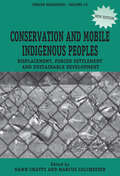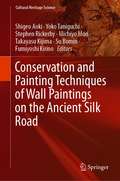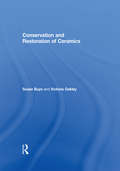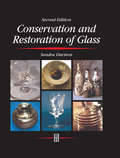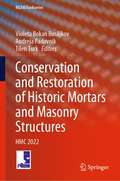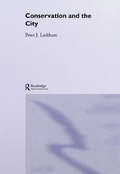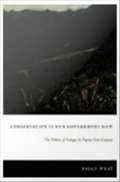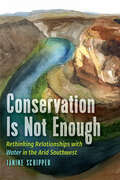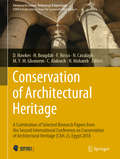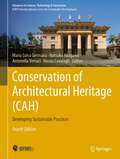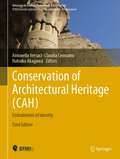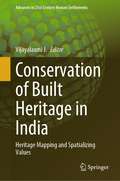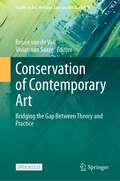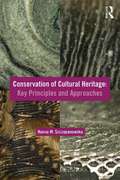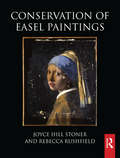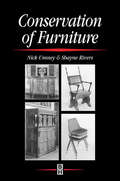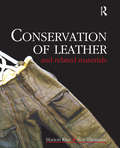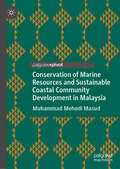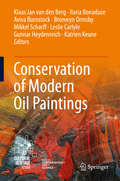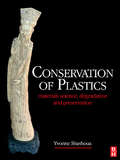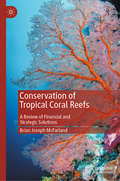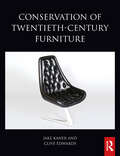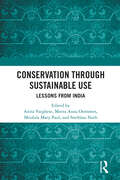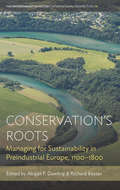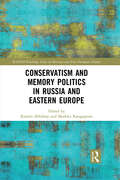- Table View
- List View
Conservation and Mobile Indigenous Peoples: Displacement, Forced Settlement and Sustainable Development (Forced Migration)
by Dawn Chatty and Marcus ColchesterThe second edition of this remarkable volume updates the immense advances in policy and soft international law with regards to the rights of mobile indigenous peoples in conservation. The contributors to this book examine the interface between conservation and indigenous communities who are forced to move or settle elsewhere to accommodate environmental policies and biodiversity concerns. The case studies investigate successful and not so successful community-managed projects in Africa, the Middle East, South and SouthEastern Asia, Australia and Latin America.
Conservation and Painting Techniques of Wall Paintings on the Ancient Silk Road (Cultural Heritage Science)
by Stephen Rickerby Shigeo Aoki Yoko Taniguchi Michiyo Mori Takayasu Kijima Su Bomin Fumiyoshi KirinoThis book presents recent research on ancient Silk Road wall paintings, providing an up-to-date analysis of their coloring materials and techniques, and of developments in efforts to preserve them.The destruction of the Bamiyan Buddhas in 2001 encouraged international collaboration between conservation research institutes to study and protect the Silk Road’s painted heritage. The collaborations led to exciting new discoveries of the rich materials used in wall painting, including diverse pigments and colorants, and various types of organic binding media. In addition, comparative research across the region revealed shared painting practices that indicate the sophisticated exchange of technologies and ideas. In parallel with these advances in technical understanding, greater awareness and sensitivity has been fostered in endeavors to preserve this fragile heritage. The book offers insights obtained from conservation projects and ongoing research, that encompass the geographical regions and periods related to the Silk Road, including from Japan, China, Korea, India and Afghanistan, and countries of the Eastern Mediterranean region. It also discusses the current issues and future challenges in the field. Featuring concise chapters, the book is a valuable resource for students and professionals in the field of cultural heritage preservation, as well as those who are not familiar with the fascinating topic of Silk Road wall painting research.
Conservation and Restoration of Ceramics (Butterworth-heinemann Series In Conservation And Museology Ser.)
by Susan Buys Victoria OakleyThe Conservation and Restoration of Ceramics brings together the wide range of current information relevant to the practising conservator. The book opens with a discussion of the fundamental nature of the ceramic medium, information which is of primary importance when selecting treatments or considering preventive conservation measures. Details on techniques are given in a series of chapters covering the restoration and conservation processes, but the emphasis is on the basic principles involved in the choice of materials and methods. The nature and properties of materials commonly in use are fully discussed and guidance is given on the facilities and equipment needed.Also covered in the book are old restoration materials and methods, the ethics of ceramics conservation, examination and recording, display treatments and emergency procedures.Now in paperback, this book will be invaluable to practising conservators and readers of conservation as well as of interest to museum curators and collectors.
Conservation and Restoration of Glass (Butterworth-heinemann Series In Conservation And Museology)
by Sandra Davison R.G. NewtonConservation and Restoration of Glass is an in-depth guide to the materials and practices required for the care and preservation of glass objects. It provides thorough coverage of both theoretical and practical aspects of glass conservation.This new edition of Newton and Davison's original book, Conservation of Glass, includes sections on the nature of glass, the historical development and technology of glassmaking, and the deterioration of glass. Professional conservators will welcome the inclusion of recommendations for examination and documentation. Incorporating treatment of both excavated glass and historic and decorative glass, the book provides the knowledge required by conservators and restorers and is invaluable for anyone with glass objects in their care.
Conservation and Restoration of Historic Mortars and Masonry Structures: HMC 2022 (RILEM Bookseries #42)
by Violeta Bokan Bosiljkov Andreja Padovnik Tilen TurkThis book gathers the latest advances, innovations and applications in the field of historic mortars and masonry structures conservation and restoration, as presented by international researchers and professionals at the 6th Historic Mortars Conference (HMC), held in Ljubljana, Slovenia, on September 21–23, 2022. It covers topics such as characterization of historic mortars and masonry structures—sampling and test methods; historic production, processing and application of mortars, renders and grouts; assessment of historic renders and plasters; conservation and preventing conservation case studies; repair mortars and grouts—requirements and design, compatibility issues, durability and effectiveness and adequacy of testing procedures. Special attention is given to historic mortars where one of the binders or the only binder is Portland cement and to the structures in which these materials are used. The contributions, which were selected through a rigorous international peer-review process, share new knowledge and exciting ideas that will help protect heritage buildings more efficiently and foster new multidisciplinary collaborations in this area.Chapter Performance Evaluation of Patch Repairs on Historic Concrete Structures (PEPS): An Overview of the Assessment Methodology is available open access under a Creative Commons Attribution 4.0 International License via link.springer.com.
Conservation and the City
by Peter LarkhamIt is a widely held belief that cities must change, or they will wither and die. One of the key problems of urbanization is how to cope with these changes while retaining the structures constructed and maintained by previous generations. Conservation and the City is a study of conservation and change throughout the built environment - city centres, suburbs and even tiny villages - and how the activites of conservation interact with the planning system. Using detailed case studies from Britain and the Westernized world, the author examines some of the key social, economic and psychological ideas which support conservation, as well as studying the urban landscape and the agents of change. Conservation and the City seeks to understand urban conservation, and in doing so presents possible solutions for managing change in the built environment of the future.
Conservation is Our Government Now: The Politics of Ecology in Papua New Guinea
by Paige WestA significant contribution to political ecology, Conservation Is Our Government Now is an ethnographic examination of the history and social effects of conservation and development efforts in Papua New Guinea. Drawing on extensive fieldwork conducted over a period of seven years, Paige West focuses on the Crater Mountain Wildlife Management Area, the site of a biodiversity conservation project implemented between 1994 and 1999. She describes the interactions between those who ran the program--mostly ngo workers--and the Gimi people who live in the forests surrounding Crater Mountain. West shows that throughout the project there was a profound disconnect between the goals of the two groups. The ngo workers thought that they would encourage conservation and cultivate development by teaching Gimi to value biodiversity as an economic resource. The villagers expected that in exchange for the land, labor, food, and friendship they offered the conservation workers, they would receive benefits, such as medicine and technology. In the end, the divergent nature of each group's expectations led to disappointment for both. West reveals how every aspect of the Crater Mountain Wildlife Management Area--including ideas of space, place, environment, and society--was socially produced, created by changing configurations of ideas, actions, and material relations not only in Papua New Guinea but also in other locations around the world. Complicating many of the assumptions about nature, culture, and development underlying contemporary conservation efforts, Conservation Is Our Government Now demonstrates the unique capacity of ethnography to illuminate the relationship between the global and the local, between transnational processes and individual lives.
Conservation is not Enough: Rethinking Relationships with Water in the Arid Southwest
by Janine SchipperConservation Is Not Enough reconsiders the most basic assumptions about water issues in the Southwest, revealing why conservation alone will not lead to a sustainable water future. The book undertakes a thorough examination of the prevailing “conservation ethos” deeply ingrained in the culture, critically analyzing its historical roots and shedding light on its problems and inherent limitations. Additionally, it explores deep ecology and an Indigenous water ethos, offering radically different ways of understanding and experiencing water. Using an exploratory and qualitative approach, the book draws on more than ninety-five interviews conducted over three years, revealing the complex relationships people have with water in the Southwest, and prominently features the voices of participants, effectively illustrating multiple perspectives and diverse ways of thinking about and relating to water. Schipper highlights various perspectives—including a water manager making conservation decisions, a Hopi elder emphasizing our connection to the water cycle, and a ski instructor reflecting on human-made snow—and interweaves personal experiences and reflections on her own relationship with water and conservation efforts. Conservation Is Not Enough encourages readers to reflect on their personal connections to water and consider new possibilities, and it also urges readers to think beyond conventional conservation approaches. This book helps to transform the collective approach to water and cultivate fresh ways of engaging with and relating to water and is of great interest to scholars, students, and residents concerned with water issues in the Colorado River Basin.
Conservation of Architectural Heritage: A Culmination of Selected Research Papers from the Second International Conference on Conservation of Architectural Heritage (CAH-2), Egypt 2018 (Advances in Science, Technology & Innovation)
by Hocine Bougdah Nabil Mohareb Dean Hawkes Chaham Alalouch Federica Rosso Nicola Cavalagli Mahmoud Yousef M. GhoneemHistory is one of the main aspects that shapes a country’s culture and leaves its traces on the built environment in the form of an architectural heritage. Such a heritage records the existence of humans, their past endeavours and in doing so preserves their cultures and traditions for future generations and contributes to the formation of their identities by acting as an inspiration for their architectural achievements. From this perspective, conservation of architectural heritage becomes important to both current and future architectural endeavours. This book discusses several topics of great importance and relevance to the conservation of worldwide architectural heritage. From historic cities and cultural landscapes to some of the largest archaeological sites in the world, conserving such a legacy is a challenging task that requires commitment, effort and international cooperation that this book proves possible. The book has an abundance of information that undoubtedly covers major areas in the field of architecture heritage. It discusses the challenges faced in the field and demonstrates the importance of such an undertaking to individuals, communities, and cities’ identity all over the world. It also highlights the role of individuals and organizations in the precise and complex process of conserving architectural heritage.
Conservation of Architectural Heritage: Developing Sustainable Practices (Advances in Science, Technology & Innovation)
by Natsuko Akagawa Antonella Versaci Nicola Cavalagli Maria Luisa GermanàThis book presents practical, applicable solutions that contribute to built heritage conservation, discussing challenges like resource constraints, ineffective legislation, lack of coordination between different relevant bodies, and absence of public awareness and involvement. This is to maintain the beauty and cultural meaning of the architectural heritage since they are like a glimpse from the past life, representing how people lived, their religions, and beliefs in addition to the primitive but inspirational technology used in construction. As a result, this book is of significant importance to professionals in the fields of architecture, sustainability, as well as policymakers.
Conservation of Architectural Heritage: Embodiment of Identity (Advances in Science, Technology & Innovation)
by Natsuko Akagawa Antonella Versaci Claudia CennamoThis book discusses the fundamentals and practical applications of heritage conservation as an important tool of a city's development. It presents case studies that demonstrate how to achieve a balance between the promotion of tourism industry and the generation of income while also seeking optimum sustainable methods for Conserving the City's Tradition and Identity. The book in hand offers useful insights to a wide array of audience aware of the need to preserve the architectural beauty of cities, such as architects, policymakers, investors and even the wide public who is interested in ways of conserving and protecting cultural sites.
Conservation of Built Heritage in India: Heritage Mapping and Spatializing Values (Advances in 21st Century Human Settlements)
by Vijayalaxmi J.This book focuses on the Heritage Conservation of Architecture, Historic Districts of a City and Conservation strategies with specific case studies from India, in order to highlight the need for conserving the rich piece of history through research, education, advocacy, and practice. The historic significance and the condition mapping of the subjects are carried out through primary field studies by the authors at School of Planning and Architecture, Vijayawada, India. The cases are analysed, and appropriate solutions and sustainable strategies are evolved for the conservation of the buildings facing contemporary challenges. The contents align with the Sustainable Development Goals (SDG 11), Target 11.4 which aims to “strengthen efforts to protect and safeguard the world's cultural and natural heritage'. This would ensure that a rich piece of history is documented and analysed to ensure that it is not erased and forgotten. This book serves as a bountiful data base of literature as well as conservation strategies for heritage conservationists, students of architectural conservation and researchers.
Conservation of Contemporary Art: Bridging the Gap Between Theory and Practice (Studies in Art, Heritage, Law and the Market #9)
by Vivian Van Saaze Renée van de VallThis open access book investigates whether and how theoretical findings and insights in contemporary art conservation can be translated into the daily work practices of conservators or, vice versa, whether and how the problems and dilemmas encountered in conservation practice can inform broader research questions and projects. For several decades now, the conservation of contemporary art has been a dynamic field of research and reflection. Because of contemporary art’s variable constitution, its care and management calls for a fundamental rethinking of the overall research landscape of museums, heritage institutions, private-sector organizations and universities. At first, this research was primarily pursued by conservation professionals working in or with museums and other heritage organizations, but increasingly academic researchers and universities became involved, for instance through collaborative projects. This book is the result of such collaboration. It sets out to bridge the “gap” between theory and practice by investigating conservation practices as a form of reflection and reflection as a form of practice.
Conservation of Cultural Heritage: Key Principles and Approaches
by Hanna M. SzczepanowskaConservation of Cultural Heritage covers the methods and practices needed for future museum professionals who will be working in various capacities with museum collections and artifacts. It also assists current professionals in understanding the complex decision-making processes that face conservators on a daily basis. The uniqueness of this book lies in correlating the aspects of material science and the behaviour of artifacts in a museum environment. It will be of special benefit to museum professionals not trained in conservation. Covering a broad range of topics that are key to sound conservation in the museum, Conservation of Cultural Heritage is an important tool for students and professionals alike in ensuring that best practice is followed in the preservation of important collections.
Conservation of Easel Paintings (Routledge Series in Conservation and Museology)
by Joyce Hill Stoner Rebecca RushfieldConservation of Easel Paintings is the first comprehensive text on the history, philosophy, and methods of treatment of easel paintings that combines both theory with practice. With contributions from an international group of experts and interviews with important artists, this volume provides an all-encompassing guide to necessary background knowledge in technical art history, artists' materials, scientific methods of examination and documentation, with sections that present varying approaches and methods for treatment, including consolidation, lining, cleaning, retouching, and varnishing. The book concludes with a section featuring issues of preventive conservation, storage, shipping, exhibition, lighting, safety issues, and public outreach. Conservation of Easel Paintings is a crucial resource in the training of conservation students and will provide generations of practicing paintings conservators and interested art historians, curators, directors, collectors, dealers, artists, and students of art and art history with invaluable information and guidance.
Conservation of Furniture (Routledge Series In Conservation And Museology Ser.)
by Shayne Rivers Nick UmneyThis book is a comprehensive resource covering the principles and practice of the conservation and restoration of furniture, and other decorative art objects made wholly or partly of wood. It integrates theory with practice to show the principles which govern interaction between wooden objects, the environmental and conservation treatments and the factors which need to be taken into account to arrive at acceptable solutions to conservation problems.The practical knowledge and experience of a team of conservators active in the field are bought together with theoretical and reference material from diverse sources and unified within a systematic framework. Specialist conservators from related disciplines cover diverse materials often incorporated into furniture.
Conservation of Leather and Related Materials
by Marion Kite Roy ThomsonThe conservation of skin, leather and related materials is an area that, until now, has had little representation by the written word in book form. Marion Kite and Roy Thomson, of the Leather Conservation Centre, have prepared a text which is both authoritative and comprehensive, including contributions from the leading specialists in their fields, such as Betty Haines, Mary Lou Florian, Ester Cameron and Jim Spriggs.The book covers all aspects of Skin and Leather preservation, from Cuir Bouillie to Bookbindings. There is significant discussion of the technical and chemical elements necessary in conservation, meaning that professional conservators will find the book a vital part of their collection. As part of the Butterworth-Heinemann Black series, the book carries the stamp of approval of the leading figures in the world of Conservation and Museology, and as such it is the only publication available on the topic carrying this immediate mark of authority.
Conservation of Marine Resources and Sustainable Coastal Community Development in Malaysia
by Muhammad Mehedi MasudThis book addresses a timely and compelling emerging issue related to the conservation and sustainable use of marine resources and the sustainable development of the coastal community. Marine protected areas (MPAs) make a remarkable contribution to the protection of marine communities by providing sustainable livelihoods, deriving financial benefits from the development of fisheries and tourism, as well as by restoring ocean productivity and preventing further environmental degradation. These areas have been considered the cornerstone of a blue economy due to their substantial economic, social and environmental contributions. However, MPAs around the world are severely hampered by a multitude of issues and challenges such as inefficient management, poor socioeconomic conditions and environmental degradation due to human activities, overexploitation of marine resources, degradation of water quality, massive waste production and climate change. These are the main obstacles to economic, social and environmental sustainability. Hence, a collaborative management approach and an integrated management policy framework is urgently needed for the economic, social, political, cultural, technological, and ecological development of coastal communities.
Conservation of Modern Oil Paintings
by Aviva Burnstock Gunnar Heydenreich Katrien Keune Klaas Jan van den Berg Ilaria Bonaduce Bronwyn Ormsby Mikkel Scharff Leslie CarlyleArtists’ oil paints have become increasingly complex and diverse in the 20th Century, applied by artists in a variety of ways. This has led to a number of issues that pose increasing difficulties to conservators and collection keepers. A deeper knowledge of the artists’ intent as well as processes associated with material changes in paintings is important to conservation, which is almost always a compromise between material preservation and aesthetics. This volume represents 46 peer-reviewed papers presented at the Conference of Modern Oil Paints held in Amsterdam in 2018. The book contains a compilation of articles on oil paints and paintings in the 20th Century, partly presenting the outcome of the European JPI project ‘Cleaning of Modern Oil Paints’. It is also a follow-up on ‘Issues in Contemporary Oil Paint’ (Springer, 2014). The chapters cover a range of themes and topics such as: patents and paint manufacturing in the 20th Century; characterization of modern-contemporary oil paints and paint surfaces; artists’ materials and techniques; the artists’ voice and influence on perception of curators, conservators and scientists; model studies on paint degradation and long term stability; approaches to conservation of oil paintings; practical surface treatment and display. The book will help conservators and curators recognise problems and interpret visual changes on paintings, which in turn give a more solid basis for decisions on the treatment of these paintings.
Conservation of Plastics
by Yvonne ShashouaPlastic objects are included more than ever in museums and galleries collections these days, but these items can start to deteriorate when they a just a few years old. In this book Yvonne Shashoua provides the essential knowledge needed to keep plastic pieces in the best possible condition so that they can continue to be enjoyed for many years. The historical development of plastics, as well as the technology, their physical and chemical properties, identification, degradation and conservation are all clearly and concisely covered within this single volume, making it an invaluable reference for the increasing number of conservators and curators that are encountering plastics in their day to day work.
Conservation of Tropical Coral Reefs: A Review of Financial and Strategic Solutions
by Brian Joseph McFarlandThis book critically engages with how the conservation of tropical coral reefs is financed. Beginning with the context of tropical coral reef degradation and loss, alongside an overview of tropical ecology, global environmental policy and finance, the book reviews several conservation financing instruments. These include ecotourism, debt-for-nature swaps, impact investments, and government domestic budgetary expenditures. From the Great Barrier Reef, to the Coral Triangle, to the Mesoamerican Reef, tropical coral reef degradation and loss are serious global environmental issues, contributing to loss revenue and food insecurity for coastal communities, and species extinction. Yet, many leading companies, individuals, and governments are making a positive impact on tropical coral reef conservation through the use of conservation finance. Conservation of Tropical Coral Reefs, using 30 case studies which span 23 countries and 6 continents, tells the history of international conservation finance and provides a variety of options for individuals, businesses, and governments to support conservation financing projects.
Conservation of Twentieth-Century Furniture (Routledge Series in Conservation and Museology)
by Clive Edwards Jake KanerConservation of Twentieth-Century Furniture provides comprehensive and accessible coverage of the materials and techniques that are encountered in furniture of this century.After putting the design, manufacture and conservation of twentieth-century furniture into context, the volume then offers an A-Z of materials organised into 12 chapters. Within each chapter a wide variety of material types are discussed, observed, analysed and contextualised, and a list of further sources is provided. The furniture discussed in this book ranges from designer craftsman, individually made pieces, to factory-produced batch items, and includes cabinet work, decoration, surface finishes and upholstery, observing the traditional repertoire of materials, as well as innovative materials and processes introduced over the course of this century. Following the material chapters, the book also includes brief case studies that illustrate some examples of twentieth-century furniture conservation, with a focus on metal, plastic and wood.Conservation of Twentieth-Century Furniture is the primary resource for those working on the manufacture, history and care of furniture of this period, including conservators, curators, dealers and collectors.
Conservation through Sustainable Use: Lessons from India
by Anita Varghese Meera Anna Oommen Mridula Mary Paul Snehlata NathThe human use of nature is a polarizing topic in India and across the globe, often perceived as contradictory to traditional exclusionary conservation. However, India’s natural landscapes serve as important sources of biological resources for many communities. This collection of case studies on sustainable use practices throughout India aims to identify the policies, management strategies, and knowledge contexts that contribute to resource use without damaging biological diversity. Through a diverse array of personal accounts, stories and photographs from the field, and ongoing research studies across biogeographic zones, readers will connect with academics, practitioners, managers, and policy analysts who challenge us to rethink the conservation paradigm. These chapters provide a reflection on the history of conservation and sustainable use in India and illuminate a path towards a local and global future in which biodiversity and human well-being go hand in hand. The wide variety of authors in this book reflects the broad audience this book will be of interest to, from students studying environmental conservation and sustainability to researchers, practitioners, and policymakers who work in the field and seek to learn about successful sustainable use systems and resulting lessons that have widespread application. This book will appeal to readers interested in the areas of environment sciences, biodiversity management, sustainable development, developmental studies, forestry, wildlife and protected area management, public policy, environmental policy, and governance.
Conservation’s Roots: Managing for Sustainability in Preindustrial Europe, 1100–1800 (Environment in History: International Perspectives #19)
by Abigail P. Dowling Richard KeyserThe ideas and practices that comprise “conservation” are often assumed to have arisen within the last two centuries. However, while conservation today has been undeniably entwined with processes of modernity, its historical roots run much deeper. Considering a variety of preindustrial European settings, this book assembles case studies from the medieval and early modern eras to demonstrate that practices like those advocated by modern conservationists were far more widespread and intentional than is widely acknowledged. As the first book-length treatment of the subject, Conservation’s Roots provides broad social, historical, and environmental context for the emergence of the nineteenth-century conservation movement.
Conservatism and Memory Politics in Russia and Eastern Europe (BASEES/Routledge Series on Russian and East European Studies)
by Katalin MiklóssyThis book discusses the diverse practices and discourses of memory politics in Russia and Eastern Europe. It argues that currently prevailing conservativism has a long tradition, which continued even in Communist times, and is different to conservatism in the West, which can accommodate other viewpoints within liberal democratic systems. It considers how important history is for conservatism, and how history is reconstituted according to changing circumstances. It goes on to examine in detail values which are key to conservatism, such as patriotism, Christianity and religious life, and the traditional model of the family, the importance of the sovereign national state within globalization, and the emphasis on a strong paternal state, featuring hierarchy, authority and political continuity. The book concludes by analysing how far states in the region are experiencing a common trend and whether different countries’ conservative narratives are reinforcing each other or are colliding.
